engine overheat TOYOTA HIGHLANDER HYBRID 2021 Owners Manual (in English)
[x] Cancel search | Manufacturer: TOYOTA, Model Year: 2021, Model line: HIGHLANDER HYBRID, Model: TOYOTA HIGHLANDER HYBRID 2021Pages: 578, PDF Size: 16.92 MB
Page 4 of 578
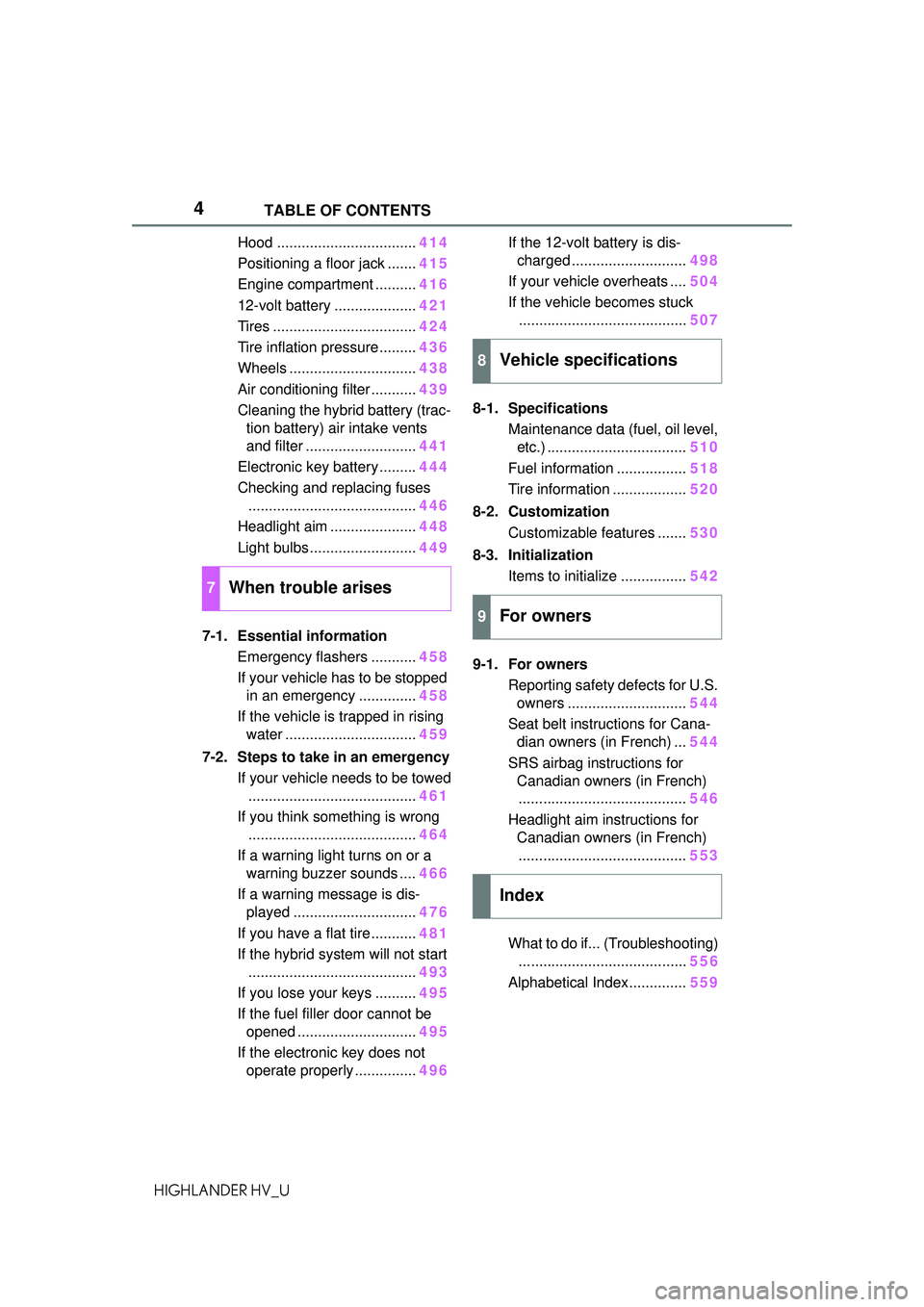
4TABLE OF CONTENTS
HIGHLANDER HV_U
Hood ..................................414
Positioning a floor jack ....... 415
Engine compartment .......... 416
12-volt battery .................... 421
Tires ................................... 424
Tire inflation pressure......... 436
Wheels ............................... 438
Air conditioning filter ........... 439
Cleaning the hybrid battery (trac- tion battery) air intake vents
and filter ........................... 441
Electronic key battery ......... 444
Checking and replacing fuses ......................................... 446
Headlight aim ..................... 448
Light bulbs .......................... 449
7-1. Essential information Emergency flashers ........... 458
If your vehicle has to be stopped in an emergency .............. 458
If the vehicle is trapped in rising water ................................ 459
7-2. Steps to take in an emergency If your vehicle needs to be towed......................................... 461
If you think something is wrong ......................................... 464
If a warning light turns on or a warning buzzer sounds .... 466
If a warning message is dis- played .............................. 476
If you have a flat tire ........... 481
If the hybrid system will not start ......................................... 493
If you lose your keys .......... 495
If the fuel filler door cannot be opened ............................. 495
If the electronic key does not operate properly ............... 496If the 12-volt battery is dis-
charged ............................ 498
If your vehicle overheats .... 504
If the vehicle becomes stuck ......................................... 507
8-1. Specifications Maintenance data (fuel, oil level, etc.) .................................. 510
Fuel information ................. 518
Tire information .................. 520
8-2. Customization Customizable features ....... 530
8-3. Initialization Items to initialize ................ 542
9-1. For owners Reporting safety defects for U.S. owners ............................. 544
Seat belt instructions for Cana- dian owners (in French) ... 544
SRS airbag instructions for Canadian owners (in French)......................................... 546
Headlight aim instructions for Canadian owners (in French)......................................... 553
What to do if... (Troubleshooting) ......................................... 55
6
Alphabetical Index.............. 559
7When trouble arises
8Vehicle specifications
9For owners
Index
Page 13 of 578

13Pictorial index
HIGHLANDER HV_UPrecautions for winter season....
.......................................... P.333
To prevent freezing (windshield wiper de-icer) ..................... P.344
Precautions for car wash
*.................................................... P.401
Fuel filler door .................................................................... P.240
Refueling method ................................................................. P.240
Fuel type/fuel tank capacity ................................................. P.511
Tires..................................................................................... P.424
Tire size/inflation pressure ........................................... P.424, 515
Winter tires/tire chains ......................................................... P.333
Checking/rotation/tire pressure warning system .................. P.424
Coping with flat tires............................................................. P.481
Hood .................................................................................... P.414
Opening ............................................................................... P.414
Engine oil ............................................................................. P.512
Coping with overheating ...................................................... P.504
Warning messages .............................................................. P.476
Front turn signal lights/parking lights
*................... P.223P.229
Parking lights
*.................................................................... P.229
Headlights/daytime running lights
*.................................. P.229
Headlights........................................................................... P.229
Daytime running lights ............... ....................................... P.229
Front side marker lights .................................................... P.229
Parking lights
*/daytime running lights*........................... P.229
Front fog lights ................................................................... P.235
Stop/tail lights .................................................................... P.229
Tail lights............................................................................. P.229
Back-up lights
Shifting the shift lever to R ................................................... P.220
Light bulbs of the exterior lights for driving
(Replacing method: P.449, Watts: P.516)
Page 85 of 578
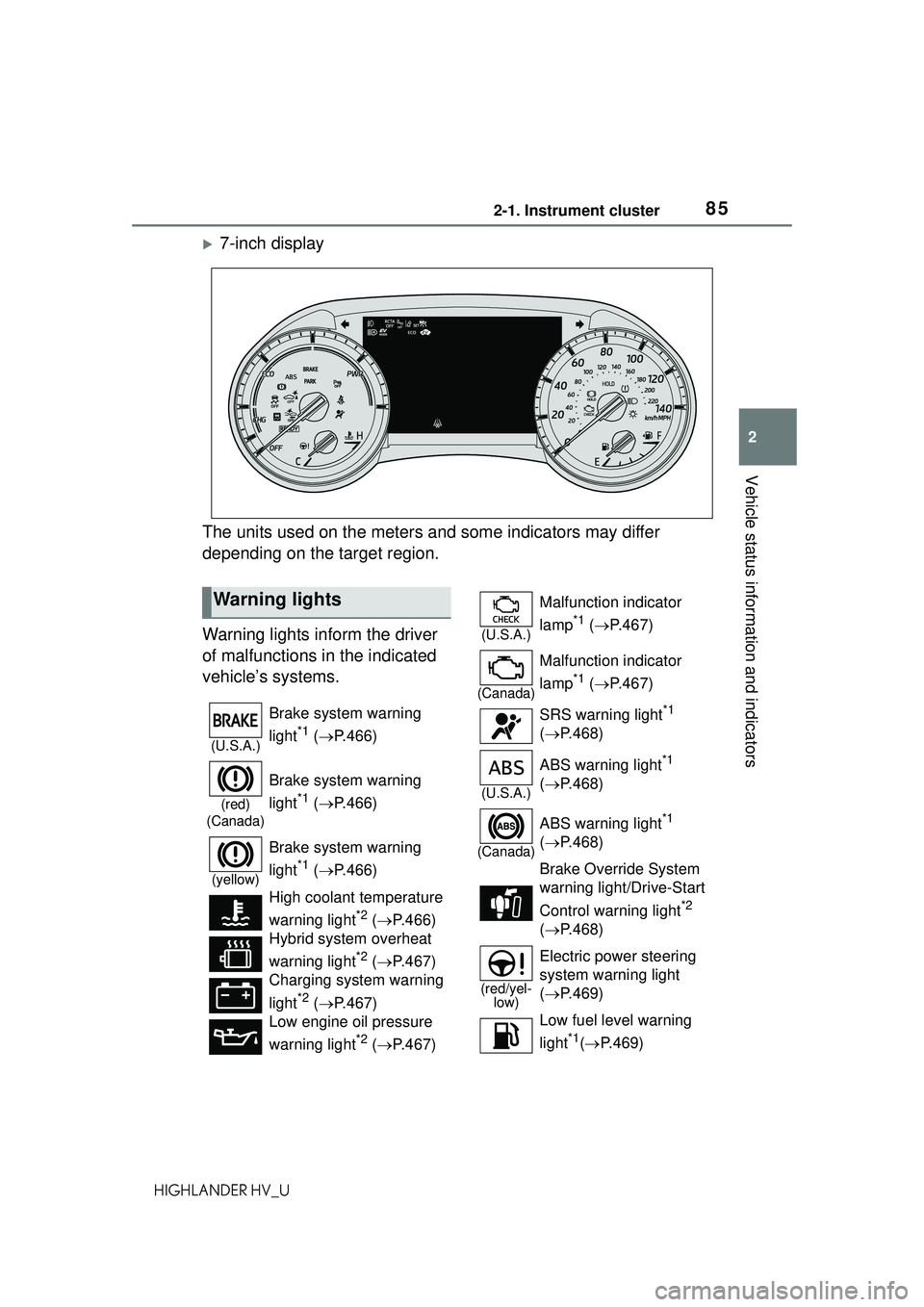
852-1. Instrument cluster
2
Vehicle status information and indicators
HIGHLANDER HV_U
7-inch display
The units used on the meters and some indicators may differ
depending on the target region.
Warning lights inform the driver
of malfunctions in the indicated
vehicle’s systems.
Warning lights
(U.S.A.)
Brake system warning
light
*1 ( P.466)
(red)
(Canada)
Brake system warning
light
*1 ( P.466)
(yellow)
Brake system warning
light
*1 ( P.466)
High coolant temperature
warning light
*2 ( P.466)
Hybrid system overheat
warning light
*2 ( P.467)
Charging system warning
light
*2 ( P.467)
Low engine oil pressure
warning light
*2 ( P.467)
(U.S.A.)
Malfunction indicator
lamp
*1 ( P.467)
(Canada)
Malfunction indicator
lamp
*1 ( P.467)
SRS warning light
*1
( P.468)
(U.S.A.)
ABS warning light*1
( P.468)
(Canada)
ABS warning light*1
( P.468)
Brake Override System
warning light/Drive-Start
Control warning light
*2
( P.468)
(red/yel-
low)
Electric power steering
system warning light
( P.469)
Low fuel level warning
light
*1( P.469)
Page 91 of 578
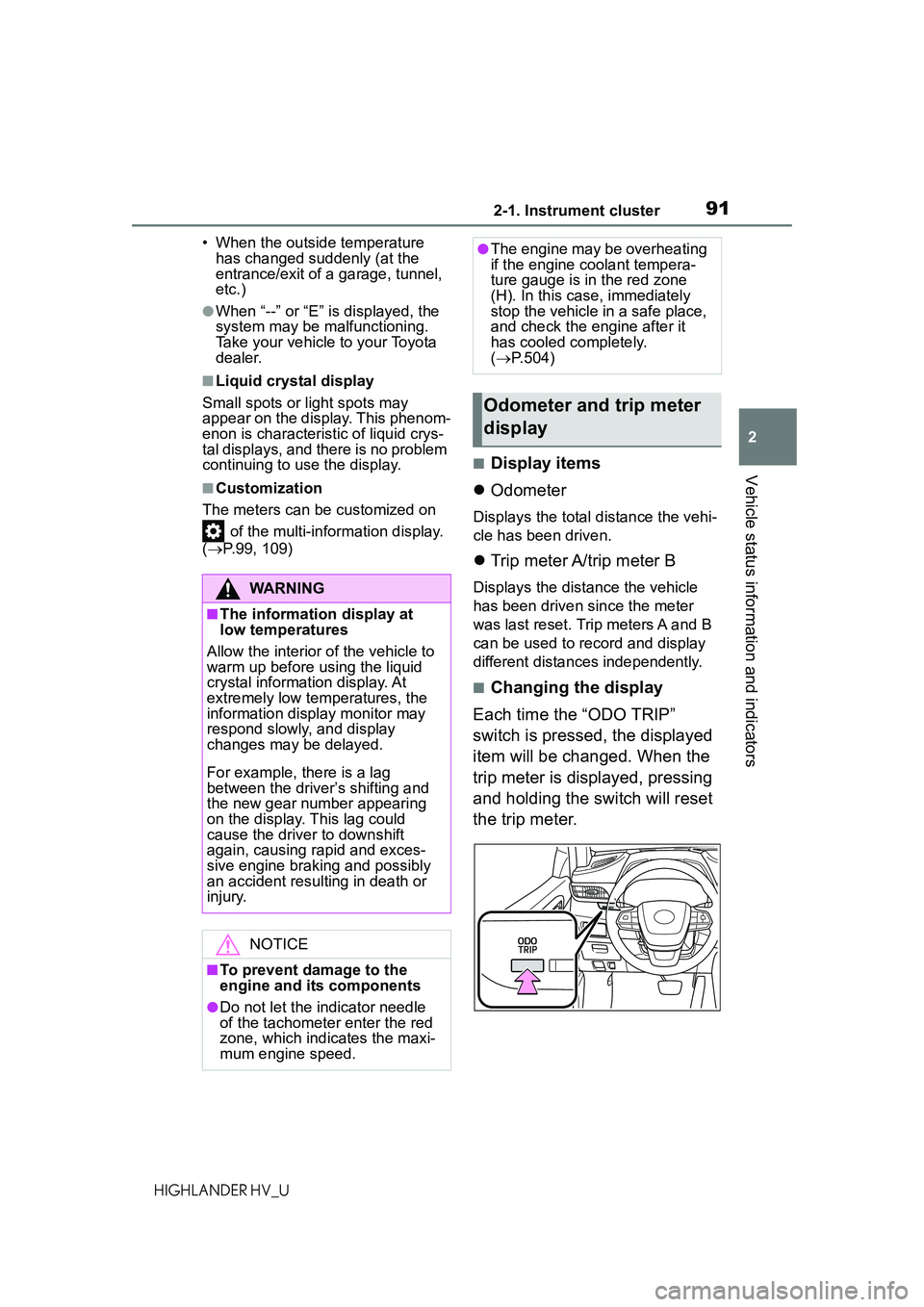
912-1. Instrument cluster
2
Vehicle status information and indicators
HIGHLANDER HV_U• When the outside temperature
has changed suddenly (at the
entrance/exit of a garage, tunnel,
etc.)
●When “--” or “E” is displayed, the
system may be malfunctioning.
Take your vehicle to your Toyota
dealer.
■Liquid crystal display
Small spots or light spots may
appear on the display. This phenom-
enon is characteristic of liquid crys-
tal displays, and there is no problem
continuing to use the display.
■Customization
The meters can be customized on of the multi-information display.
( P.99, 109)
■Display items
Odometer
Displays the total distance the vehi-
cle has been driven.
Trip meter A/trip meter B
Displays the distance the vehicle
has been driven since the meter
was last reset. Trip meters A and B
can be used to record and display
different distances independently.
■Changing the display
Each time the “ODO TRIP”
switch is pressed, the displayed
item will be changed. When the
trip meter is displayed, pressing
and holding the switch will reset
the trip meter.
WARNING
■The information display at
low temperatures
Allow the interior of the vehicle to
warm up before using the liquid
crystal information display. At
extremely low temperatures, the
information display monitor may
respond slowly, and display
changes may be delayed.
For example, there is a lag
between the driver’s shifting and
the new gear number appearing
on the display. This lag could
cause the driver to downshift
again, causing rapid and exces-
sive engine braking and possibly
an accident resulting in death or
injury.
NOTICE
■To prevent damage to the
engine and its components
●Do not let the indicator needle
of the tachometer enter the red
zone, which indicates the maxi-
mum engine speed.
●The engine may be overheating
if the engine coolant tempera-
ture gauge is in the red zone
(H). In this case, immediately
stop the vehicle in a safe place,
and check the engine after it
has cooled completely.
( P.504)
Odometer and trip meter
display
Page 194 of 578
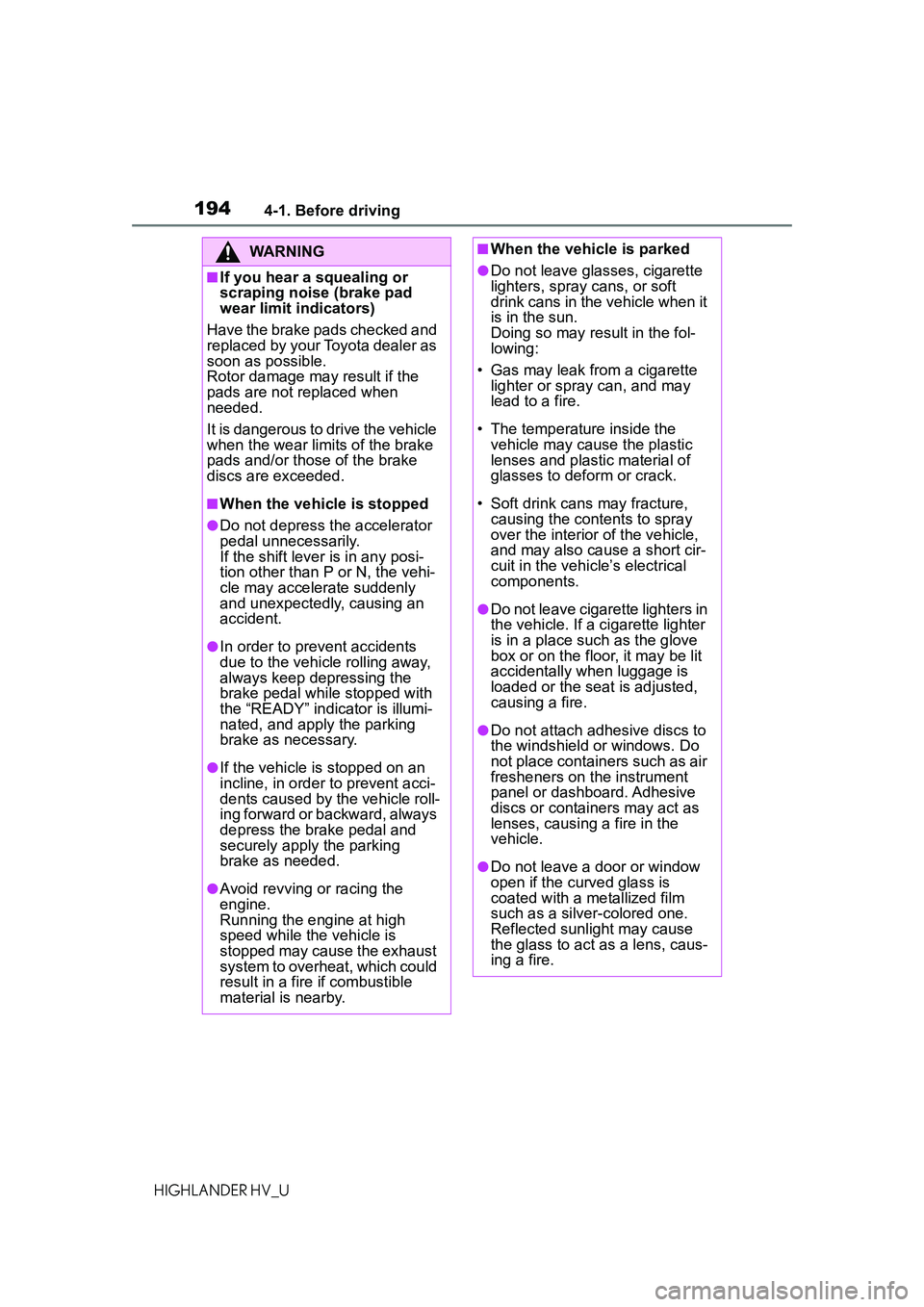
1944-1. Before driving
HIGHLANDER HV_U
WARNING
■If you hear a squealing or
scraping noise (brake pad
wear limit indicators)
Have the brake pads checked and
replaced by your Toyota dealer as
soon as possible.
Rotor damage may result if the
pads are not replaced when
needed.
It is dangerous to drive the vehicle
when the wear limits of the brake
pads and/or those of the brake
discs are exceeded.
■When the vehicle is stopped
●Do not depress the accelerator
pedal unnecessarily.
If the shift lever is in any posi-
tion other than P or N, the vehi-
cle may accelerate suddenly
and unexpectedly, causing an
accident.
●In order to prevent accidents
due to the vehicle rolling away,
always keep depressing the
brake pedal while stopped with
the “READY” indicator is illumi-
nated, and apply the parking
brake as necessary.
●If the vehicle is stopped on an
incline, in order to prevent acci-
dents caused by the vehicle roll-
ing forward or backward, always
depress the brake pedal and
securely apply the parking
brake as needed.
●Avoid revving or racing the
engine.
Running the engine at high
speed while the vehicle is
stopped may cause the exhaust
system to overheat, which could
result in a fire if combustible
material is nearby.
■When the vehicle is parked
●Do not leave glasses, cigarette
lighters, spray cans, or soft
drink cans in the vehicle when it
is in the sun.
Doing so may result in the fol-
lowing:
• Gas may leak from a cigarette lighter or spray can, and may
lead to a fire.
• The temperature inside the vehicle may cause the plastic
lenses and plastic material of
glasses to deform or crack.
• Soft drink cans may fracture, causing the contents to spray
over the interior of the vehicle,
and may also cause a short cir-
cuit in the vehicle’s electrical
components.
●Do not leave cigarette lighters in
the vehicle. If a cigarette lighter
is in a place such as the glove
box or on the floor, it may be lit
accidentally when luggage is
loaded or the seat is adjusted,
causing a fire.
●Do not attach adhesive discs to
the windshield or windows. Do
not place containers such as air
fresheners on the instrument
panel or dashboard. Adhesive
discs or containers may act as
lenses, causing a fire in the
vehicle.
●Do not leave a door or window
open if the curved glass is
coated with a metallized film
such as a silver-colored one.
Reflected sunlight may cause
the glass to act as a lens, caus-
ing a fire.
Page 210 of 578

2104-1. Before driving
HIGHLANDER HV_U
requires practice. Grip the
bottom of the steering wheel
and move your hand to the
left to move the trailer to the
left. Move your hand to the
right to move the trailer to
right. (This is generally oppo-
site to reversing without a
trailer attached.) Avoid sharp
or prolonged turning. Have
someone guide you when
reversing to reduce the risk of
an accident.
As stopping distance is
increased when towing a
trailer, vehicle-to vehicle dis-
tance should be increased.
For each 10 mph (16 km/h) of
speed, allow at least one
vehicle and trailer length.
Avoid sudden braking as you
may skid, resulting in the
trailer jackknifing and a loss of
vehicle control. This is espe-
cially true on wet or slippery
surfaces.
Avoid jerky starts or sudden
acceleration.
Avoid jerky steering and
sharp turns, and slow down
before making turn.
Note that when making a turn,
the trailer wheels will be
closer than the vehicle wheels
to the inside of the turn. Com-
pensate by making a wider
than normal turning radius.
Slow down before making a turn, in cross winds, on wet or
slippery surfaces, etc.
Increasing vehicle speed can
destabilize the trailer.
Take care when passing other
vehicles. Passing requires
considerable distance. After
passing a vehicle, do not for-
get the length of your trailer,
and be sure you have plenty
of room before changing
lanes.
To maintain engine braking
efficiency and charging sys-
tem performance when using
engine braking, do not put the
transmission in D. If in the S
mode, the hybrid transmission
shift range position must be in
5 or lower. ( P.220)
Instability happens more fre-
quently when descending
steep or long downhill grades.
Before descending, slow
down and downshift. Do not
make sudden downshifts
while descending steep or
long downhill grades.
Avoid holding the brake pedal
down too long or applying the
brakes too frequently. This
could cause the brakes to
overheat and result in
reduced braking efficiency.
Due to the added load of the
trailer, your vehicle’s engine
may overheat on hot days (at
temperatures over 85°F
[30°C]) when driving up a long
Page 211 of 578
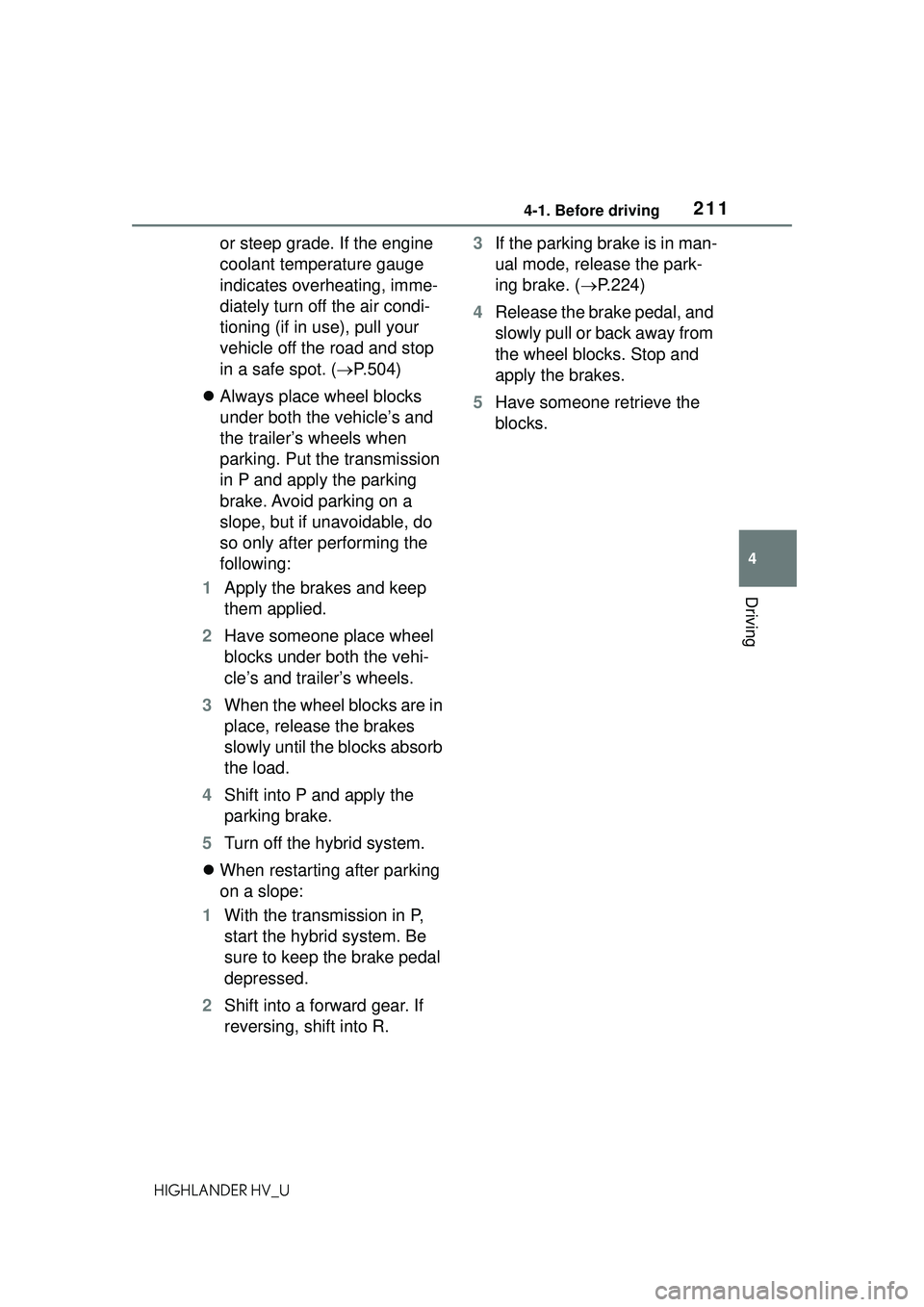
2114-1. Before driving
4
Driving
HIGHLANDER HV_U
or steep grade. If the engine
coolant temperature gauge
indicates overheating, imme-
diately turn off the air condi-
tioning (if in use), pull your
vehicle off the road and stop
in a safe spot. (P.504)
Always place wheel blocks
under both the vehicle’s and
the trailer’s wheels when
parking. Put the transmission
in P and apply the parking
brake. Avoid parking on a
slope, but if unavoidable, do
so only after performing the
following:
1 Apply the brakes and keep
them applied.
2 Have someone place wheel
blocks under both the vehi-
cle’s and trailer’s wheels.
3 When the wheel blocks are in
place, release the brakes
slowly until the blocks absorb
the load.
4 Shift into P and apply the
parking brake.
5 Turn off the hybrid system.
When restarting after parking
on a slope:
1 With the transmission in P,
start the hybrid system. Be
sure to keep the brake pedal
depressed.
2 Shift into a forward gear. If
reversing, shift into R. 3
If the parking brake is in man-
ual mode, release the park-
ing brake. ( P.224)
4 Release the brake pedal, and
slowly pull or back away from
the wheel blocks. Stop and
apply the brakes.
5 Have someone retrieve the
blocks.
Page 467 of 578
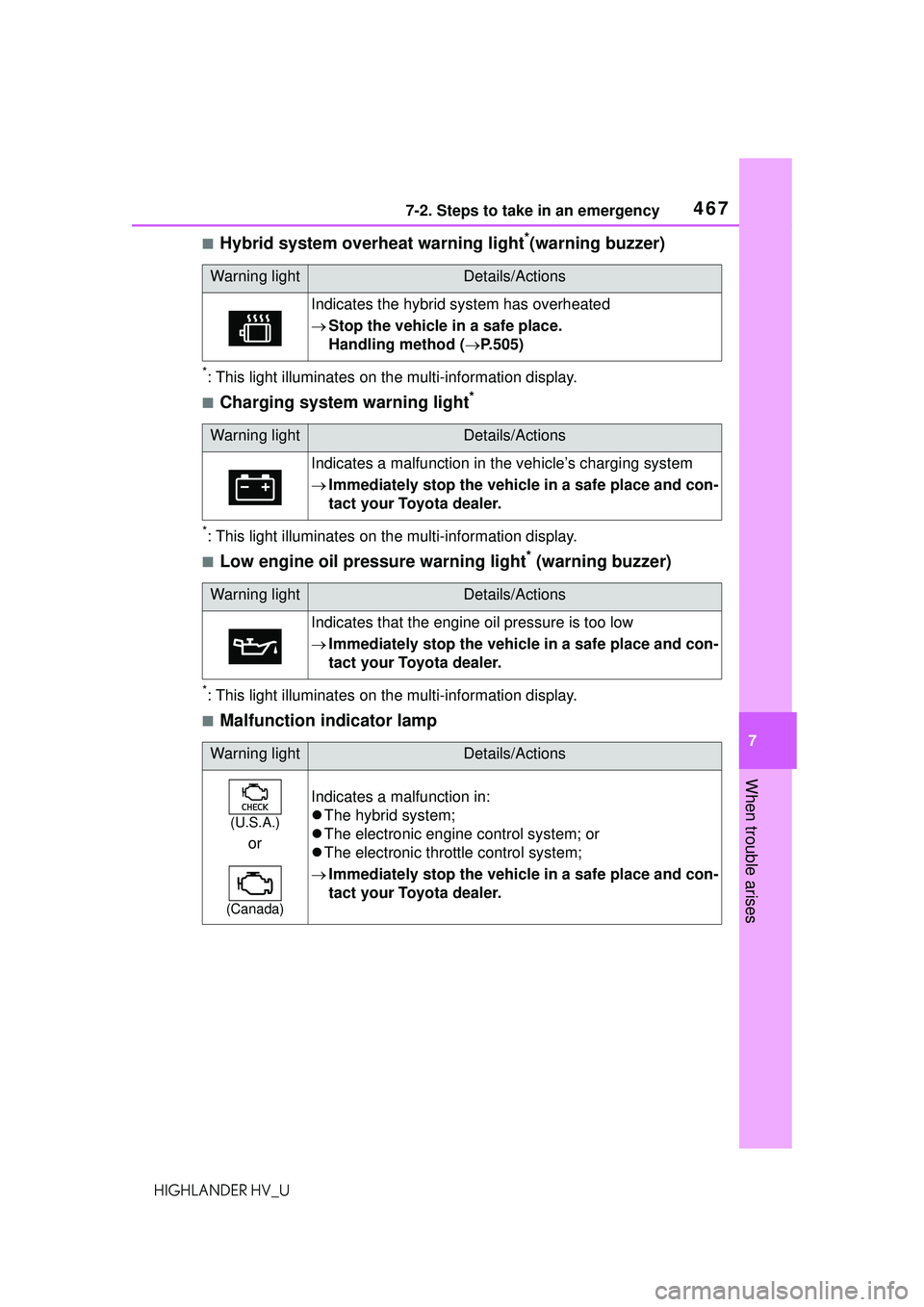
4677-2. Steps to take in an emergency
7
When trouble arises
HIGHLANDER HV_U
■Hybrid system overheat warning light*(warning buzzer)
*: This light illuminates on the multi-information display.
■Charging system warning light*
*: This light illuminates on the multi-information display.
■Low engine oil pressure warning light* (warning buzzer)
*: This light illuminates on the multi-information display.
■Malfunction indicator lamp
Warning lightDetails/Actions
Indicates the hybrid system has overheated
Stop the vehicle in a safe place.
Handling method ( P.505)
Warning lightDetails/Actions
Indicates a malfunction in the vehicle’s charging system
Immediately stop the vehicle in a safe place and con-
tact your Toyota dealer.
Warning lightDetails/Actions
Indicates that the engine oil pressure is too low
Immediately stop the vehicle in a safe place and con-
tact your Toyota dealer.
Warning lightDetails/Actions
(U.S.A.)
or
(Canada)
Indicates a malfunction in:
The hybrid system;
The electronic engine control system; or
The electronic throttle control system;
Immediately stop the vehicle in a safe place and con-
tact your Toyota dealer.
Page 504 of 578
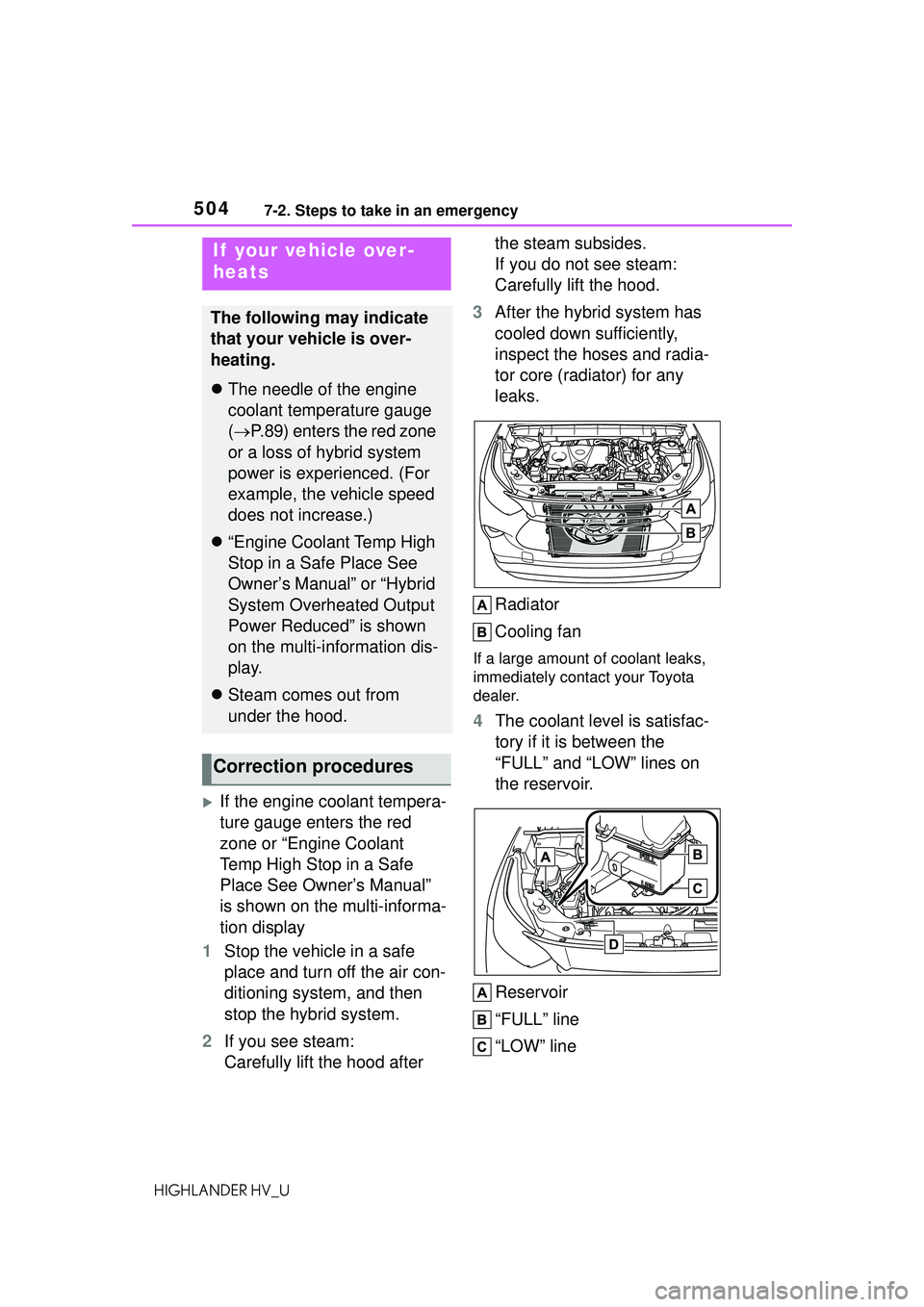
5047-2. Steps to take in an emergency
HIGHLANDER HV_U
If the engine coolant tempera-
ture gauge enters the red
zone or “Engine Coolant
Temp High Stop in a Safe
Place See Owner’s Manual”
is shown on the multi-informa-
tion display
1 Stop the vehicle in a safe
place and turn off the air con-
ditioning system, and then
stop the hybrid system.
2 If you see steam:
Carefully lift the hood after the steam subsides.
If you do not see steam:
Carefully lift the hood.
3 After the hybrid system has
cooled down sufficiently,
inspect the hoses and radia-
tor core (radiator) for any
leaks.
Radiator
Cooling fan
If a large amount of coolant leaks,
immediately contact your Toyota
dealer.
4The coolant level is satisfac-
tory if it is between the
“FULL” and “LOW” lines on
the reservoir.
Reservoir
“FULL” line
“LOW” line
If your vehicle over-
heats
The following may indicate
that your vehicle is over-
heating.
The needle of the engine
coolant temperature gauge
( P.89) enters the red zone
or a loss of hybrid system
power is experienced. (For
example, the vehicle speed
does not increase.)
“Engine Coolant Temp High
Stop in a Safe Place See
Owner’s Manual” or “Hybrid
System Overheated Output
Power Reduced” is shown
on the multi-information dis-
play.
Steam comes out from
under the hood.
Correction procedures
Page 506 of 578
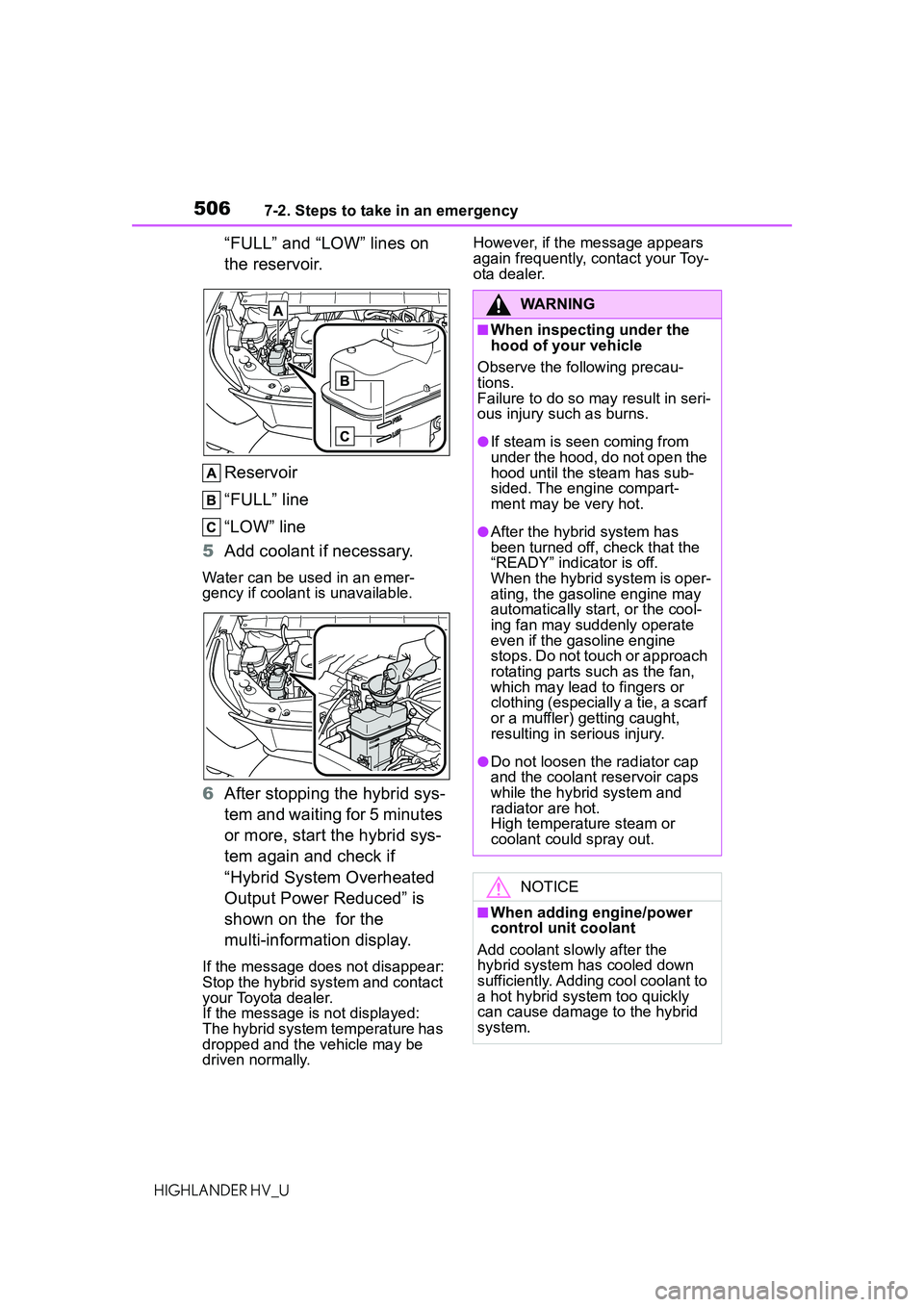
5067-2. Steps to take in an emergency
HIGHLANDER HV_U
“FULL” and “LOW” lines on
the reservoir.
Reservoir
“FULL” line
“LOW” line
5 Add coolant if necessary.
Water can be used in an emer-
gency if coolant is unavailable.
6After stopping the hybrid sys-
tem and waiting for 5 minutes
or more, start the hybrid sys-
tem again and check if
“Hybrid System Overheated
Output Power Reduced” is
shown on the for the
multi-information display.
If the message does not disappear:
Stop the hybrid system and contact
your Toyota dealer.
If the message is not displayed:
The hybrid system temperature has
dropped and the vehicle may be
driven normally. However, if the message appears
again frequently, contact your Toy-
ota dealer.
WARNING
■When inspecting under the
hood of your vehicle
Observe the following precau-
tions.
Failure to do so may result in seri-
ous injury such as burns.
●If steam is seen coming from
under the hood, do not open the
hood until the steam has sub-
sided. The engine compart-
ment may be very hot.
●After the hybrid system has
been turned off, check that the
“READY” indicator is off.
When the hybrid system is oper-
ating, the gasoline engine may
automatically start, or the cool-
ing fan may suddenly operate
even if the gasoline engine
stops. Do not touch or approach
rotating parts such as the fan,
which may lead to fingers or
clothing (especially a tie, a scarf
or a muffler) getting caught,
resulting in serious injury.
●Do not loosen the radiator cap
and the coolant reservoir caps
while the hybrid system and
radiator are hot.
High temperature steam or
coolant could spray out.
NOTICE
■When adding engine/power
control unit coolant
Add coolant slowly after the
hybrid system has cooled down
sufficiently. Adding cool coolant to
a hot hybrid system too quickly
can cause damage to the hybrid
system.